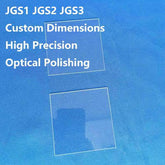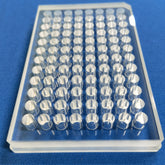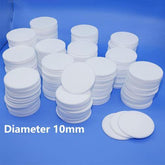The important role of sapphire glass in semiconductor equipment manufacturing
Sapphire glass is a key component in the field of high technology, particularly in the production of semiconductor devices. Its core ingredient, high-purity alumina, endows sapphire glass with a range of unique physical and chemical properties, making it an ideal material for many high-tech applications.
1. Applications in semiconductor devices
(1) As a substrate material for LED chips
A LED chip constitutes the core component of an LED lamp, with its performance having a direct impact on the luminous efficiency and life of the lamp. Sapphire glass has become an ideal substrate material for manufacturing LED chips due to its high light transmittance, high thermal stability and chemical stability. The growth of the LED epitaxial layer on the sapphire substrate is pivotal in the fabrication of high-performance LED chips, which find extensive application in lighting, display, and other domains.
 (2) As a packaging material for integrated circuits
(2) As a packaging material for integrated circuits
Integrated circuits represent the core of contemporary electronic apparatus, with the quality of their packaging exerting a direct influence on the performance and reliability of the equipment. Due to its elevated hardness, considerable wear resistance and excellent insulation properties, sapphire glass has become the material of choice for integrated circuit packaging. It has been demonstrated that sapphire glass can effectively protect integrated circuits from damage caused by external environmental factors, thereby enhancing the stability and service life of the equipment.
(3) As a window material for sensors and photoelectric devices
Sensors and optoelectronic devices represent a pivotal component of contemporary electronic apparatus, which function by detecting information from the external environment and converting it into electrical signals. Due to its high light transmittance, substantial chemical stability, and commendable mechanical properties, sapphire glass has been identified as an optimal material for the fabrication of sensors and optoelectronic device windows. It ensures the accurate reception and transmission of optical signals during operation, enhancing the sensitivity and reliability of the device.

(4) As a radiating fin for power devices
Power devices are significant consumers of energy in electronic equipment, generating substantial heat during operation. If these devices do not dissipate this heat in a timely manner, it can lead to an increase in device temperature, a decline in performance, or even potential damage. Sapphire glass is the preferred material for manufacturing radiating fin of power devices due to its good thermal conductivity and chemical stability. Sapphire glass is able to effectively conduct the heat generated by the device, thus maintaining its normal operating temperature and enhancing its working efficiency and reliability.
Sapphire glass is a high-performance material with unique physical and chemical properties, making it an essential component in the manufacture of semiconductor devices. Its high hardness, wear resistance, light transmittance, thermal stability and chemical stability make it an ideal material for manufacturing LED chip substrates, integrated circuit packaging materials, sensors and optoelectronic device windows, and power device radiating fin.






